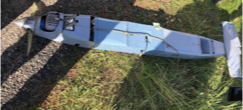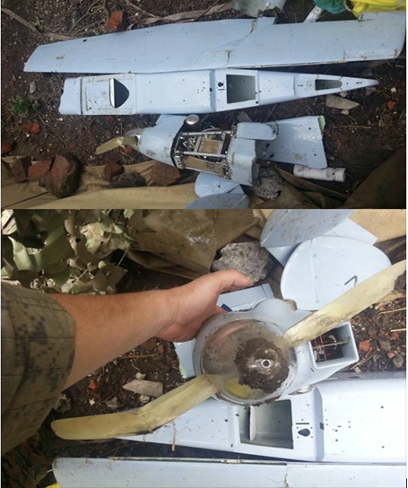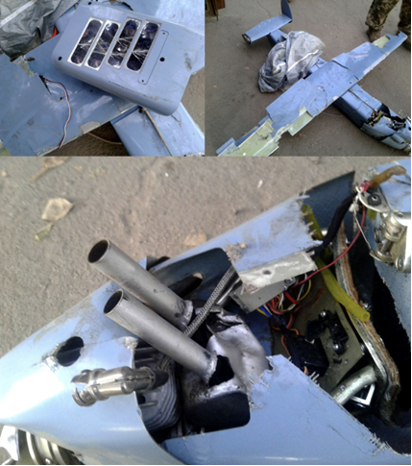Article
SensusQ UAV analysis on the Orlan-20

Keywords: Unmanned Aircraft Systems (UAS), Unmanned Aerial Vehicle (UAV), Intelligence, Surveillance, and Reconnaissance (ISR), Open Sources Intelligence (OSINT), Ukraine, Russia, Conflict
According to Oryxspioenkop five destroyed or captured Russian unnamed reconnaissance UAVs’ have been documented in Ukraine to date.[1]A similar UAV appeared in Donbas in 2014 (Figure 3) and has also been observed in Turkey and Syria (Figure 6) in 2015 and later in the Anti-Terrorist Operation Zone (ATO) in Ukraine (Figure 4) and in EU countries.[2][3][4][5][6]The unnamed UAV is equipped with 12 camera lenses for aerial mapping and video capture with the possibility of transmitting some of the collected information in real-time.[2][4][6][8][11]Captured UAVs have included British, Czech, French, German, Spanish, Japanese, and American components. [5]
1. Emergence of the unnamed UAV

On 6th May 2022, a Russian reconnaissance UAV was downed by Ukrainian forces. Reportedly this UAV was produced by a company working with the manufacturer of Orlan UAVs, the Saint Petersburg based Special Technology Centre.[7] On May 17th a second ‘secret’ unnamed Russian UAV, equipped with 12 camera lenses, was shot down in Dnipropetrovsk Oblast. Twitter bloggers started calling these UAVs Orlan-20s.[8] (Figure 1)
On June 2nd a video of the Ukrainian S-300PT anti-aircraft missile system was published on YouTube, which demonstrated another downed Russian reconnaissance UAV.[9] (Figure 2)

On June 13th a Russian UAV was shot down by an anti-aircraft missile unit of the ‘South’ air command in the Mykolaiv region. Ukraine Operational Command South stated that “With the help of the UAVs, the enemy tried to conduct aerial reconnaissance in order to disrupt our counter-offensive attacks“.[10]
On July 31st Ukraine’s 9K37M1 Buk-M1 anti-aircraft missile system shot down a classified Russian mapping UAV in Sumy oblast. This unique UAV is often confused with another Russian UAV, the Orlan-10. The UAV visually resembles those of the Orlan family, but there are some differences. The UAV is equipped with a 12-lens camera for panoramic aerial photos and video shooting with the possibility of transmitting the collected information to the control point in real time. Individual components of the UAV, in particular the optical-electronic system, were produced by a Russian company currently under United States sanctions. The same company works together with the Orlan UAV manufacturing plant.[11] [Figure 7]
1.1 First captured unnamed Russian reconnaissance UAVs

On May 30th 2014 Ukraine stated that it had captured a Russian spy UAV.(Figure 3) While the craft design appeared clunky by modern design standards, the SBU claimed that it was a modification of the Orlan-10 drone that had 3D mapping and real-time battle monitoring capabilities. The captured UAV could carry a thermal camera for night vision, a still camera, and a gyro-stabilized video camera, depending on the specific build, the SBU said. The craft also carried a capsule containing an unknown chemical. The captured UAV was shot down with a ‘high-precision technological weapon’, no further details were released.[2]
An unidentified UAV was downed by Turkish jets in southern Kilis province, bordering with Syria, on October 16th 2015.[3]
A third UAV equipped with 12-cameras crashed near Ruveysli in Syria on July 20th 2015 indicating that Russia had embarked on a UAV surveillance programme over Syria. Probably as part of Russias programme to provide the Syrian regime with up-to-date intelligence on the operational status of rebels in the region. This operation first became known after the capture of a Center S SIGINT facility near al-Hara, Daraa Governorate, which was operated by the Russian GRU.[4] (Figure 4)


On February 8th 2017 Ukranian defence forces captured a UAV containing UK manufactured components near the city of Mariupol in the Donetsk region.[5]
In the following August, another Russian UAV equipped with a similar panoramic camera was shot down by a Ukrainian air defence unit in Donbass. The Russian UAV was conducting aerial reconnaissance of Ukrainian defence lines at a section of the forefront near Pervomaisk, Severodonetsk, and Svatove in the occupied Donbas region. Examination of the UAV revealed that it was equipped with a 12-lens panoramic camera for aerial survey, capable of transferring some of the collected information to the control unit in real time. Individual components of the UAV, namely its optoelectronic system, were manufactured by a Russian company on the United States sanction list, a firm also known to cooperate with the plant producing Orlan UAVs. This proved that the Russian Federation supplied weapons to Donbas that were used by occupying forces against the Ukrainian army.[6] (Figure 5)
1.2 Western components found on downed Russian spy UAVs

One of the UAVs containing UK manufactured components was captured by Ukrainian defence forces near the city of Mariupol in Donetsk region on February 8th 2017. (Figure 6) The analysis of the equipment by Conflict Armament Research (CAR) found an inertial measurement unit (IMU) manufactured by a British firm. The same British firm manufactures another component that was found in a UAV that crashed in Lithuania during October 2016.[5]
The British company sold the DMU02 unit to Radiant-Elcom CJSC, now known as Radiant Group LLC, a Russian civilian electronics distributor. Radiant said the end customer was a company that serves ‘various educational institutions’ throughout the country.
The unit’s final destination was found to be ANO ‘PO KSI’, a Moscow based research and development firm whose primary client is Russian Ministry of Defence, and which produces aerial surveillance systems.[12] The company was sanctioned by the United States in 2016 for allegedly aiding Russian military intelligence agency cyber-operations.[5]
The measurement unit manufactured by the UK company was sold before August 1st 2014, when the EU and the United States banned trade in arms or ‘related material’ with Russian firms. Another unit manufactured by the Plymouth-based firm was found on the UAV recovered by Lithuanian authorities. It was most likely sold to Radiant-Elcom between 2014 and 2015. Neither of the commercially available components traced back to the British company are on the UK Strategic Export Control List. Another electrical component found in the UAV recovered in Ukraine was manufactured by the Japanese firm NGK Spark Plugs. The company specifically states on its website that its components should not be used in aeronautical applications.[5]
The investigation also found components sent by a German company to Russian citizen owned World Logistics Group, which was registered in the Czech Republic before it ceased trading in October 2018. One of the company’s directors was a Russian citizen with links to the political and security agencies of the Russian government. Russian manufactured UAVs captured in EU member states, have included British, Czech, French, German, Spanish and American components.[5]
2. Conclusion

Apparently, like the Orlan-10, the unnamed UAV uses cheap imported components that are commercially available. The components are not only cost effective, but are also not covered by legislation on the circulation of military technologies in the same way ITAR or dual use goods are. Regardless, most of the electronics and engines of the UAV are imported components, the UAV’s designers have taken great steps to ensure that no critical component of the drone is unique to one manufacturer. The IMU found in the UAVs in 2017 was already a dated technology which has been replaced by Inertial Navigation Systems (INS) that contain IMUs on modern and more sophisticated UAVs. It is possible that the UAVs destroyed during the Russian invasion of Ukraine do not have IMUs from the UK company, but an IMU from another company, as there are many such solutions available on the commercial market. Depending on budgetary constraints the recent modification may also have more modern technology installed such as INS. Unfortunately, this information has not been made public.
Such an UAV can be mainly assembled from components used in model aviation. The SBU aptly said in 2014 that the craft looked clunky. Most of the components required to assemble the UAV are available and relatively cheap in the model aviation market. The photos show that the wiring is unshielded and only fiberglass is used as a composite material, further reduces the manufacturing cost. It is surprising that two Pitot tubes are used to measure the air speed, as one is usually sufficient for such a cheap grade UAV, but this may be a redundancy requirement.
The UAV Aerial Mapping Payload is quite well developed and allows for ultra-precise 3D mapping. 12 cameras, which look from different angles, thus cover a wider corridor on a single flight, reducing the risk of being targeted by enemy air defence weapons. The lenses are relatively long and are positioned so that all the necessary information can be obtained in one sortie. It is unlikely that such an aerial mapping payload would cost more than US$100,000 in Russia, as claimed in open sources.[6] In order to keep the price low, cameras in such a payload could be purchased from online stores such as Ali Express for less than €100. A little more work for engineers and payload could be completed for US$10,000-20,000. Although the quality of the payload would likely not match Western standards, it would perform the same core function for a tenth of the cost.
Despite open sources claiming that this UAV is capable of transmitting the collected information to the control unit in real time, it is unlikely that it can simultaneously transmit imagery from 12 cameras, as well as process and merge imagery on board. This would require enormous bandwidth, multiple video processors, computing power, etc. It is more likely able to transmit only one feed from one camera at a time, or we would expect to see an additional gimbal for that purpose.
Due to the similar size, appearance, and even the use of the same details, it can be assumed that the unnamed UAV speed, distance, etc. The performance parameters are of the same scale as Orlan-10. Therefore, the maximum speed of the UAV is likely 100-150 km/h, the maximum operating range up to 120 km from the ground control station without relay UAV support or up to 600km offline, the maximum endurance: 10 hours and maximum service ceiling: 6,000m.
Russia continues to search for new ways to apply its latest weapons and military equipment to actual combat situations in Ukraine. At the same time, Russia is engaged in research to assess the real capabilities of its military equipment, using the occupied territories of Ukraine as a testing ground. Although the unnamed UAV is probably not new equipment, comparing the photos of the UAV destroyed in 2014 with the photos of the UAVs destroyed in the 2022 Russian invasion of Ukraine shows that changes have been made to the UAV's design over time. [Figures 1, 3, 4, 5] It is likely that the war in Ukraine will continue to be a valuable testing ground for Russia in the development of military equipment.
According to Oryxspienkop[1], the unnamed UAV is the third most destroyed UAV in Ukraine after Orlan-10 and Eleron-3. Thus, it is not so much a secret UAV as a rather common UAV whose name and purpose have not been disclosed by Russia for unknown reasons. It is possible that the main user of this UAV is a branch of the Russian secret service, for whom it is customary not to disclose information related to them. Indeed, open sources have suggested that the main user of this UAV may be the FSB.[11] However, mapping the battlefield and long-range reconnaissance are not the responsibility of the FSB, but rather of the GRU. The connection with the GRU is also indicated by the fact that one of the first unnamed UAVs was destroyed in Syria while the GRU was actively involved there at Centre S SIGINT facility near al-Hara, Daraa Governorate.[4] It is quite possible that the name of the UAV is unknown because its main operator has been the GRU and therefore it still holds the reputation of a ‘secret’ reconnaissance UAV. According to open sources, the number of UAVs of this type that have been intercepted over the years is already ten or more, and therefore it is quite unlikely that this ‘secret’ UAV could conceal some important secrets that would be unknown to specialists from the Ukrainian armed forces and NATO member states. Ukrainian air defence troops, whose capabilities are steadily improving, are likely to destroy several more UAVs of this type before Russia's invasion of Ukraine comes to an end.
REFERENCES
[1] Attack On Europe: Documenting Russian Equipment Losses During The 2022 Russian Invasion Of Ukraine. Aug 2022. [Online] oryxspioenkop.com/2022/02/attack-on-europe-documenting-equipment.html?fbclid=IwAR076y52Z1Q8ACJeLda9eXBBmvS2KuATHu4-_sX2HAU_WYgl0tz7qnpEmck
[2] Ukraine Says it Shot Down a Russian Spy Drone. May 2014. [Online] Available: vice.com/en/article/zm58e8/ukraine-says-it-shot-down-a-russian-spy-drone
[3] Turkey downs 'unidentified aircraft' violating air space. Oct 2015. [Online] Available: gettyimages.com/detail/news-photo/an-aircraft-is-seen-after-it-was-downed-by-turkish-jets-in-news-photo/492931138
[4] Russian Orlan-10 And Eleron-3SV Drones Take To Syria’s Skies. Jun 2015. [Online] oryxspioenkop.com/2015/07/russian-orlan-10-and-eleron-3sv-drones.html
[5] British parts found on downed Russian spy drones in Ukraine and EU. Feb 2022. [Online]. Available: metro.co.uk/2022/02/04/british-parts-found-on-downed-russian-spy-drones-in-ukraine-and-eu-16048519/
[6] Силы ООС сбили российский БПЛА-разведчик, оснащенный камерой с 12 объективами для панорамной съемки. Aug 2018. [Online] Available: censor.net/ru/n3081748
[7] Twitter:@Arslon_Xudosi. May 2022. [Online] Available: twitter.com/Arslon_Xudosi/status/1522327278860054531
[8] Twitter:@UAWeapons. May 2022. [Online] Available: twitter.com/UAWeapons/status/1526654429470023688
[9] YouTube: Anatolijus Len nato_Ua_aLen. Jun 2022. [Online] Available: youtube.com/watch?v=WqUO3Yr1jUo
[10] Силы ООС сбили российский БПЛА-разведчик, оснащенный камерой с 12 объективами для панорамной съемки. Aug 2022. [Online] Available: censor.net/ru/n3081748
[11] Ukraine’s Buk-M1 anti-aircraft missile system shot down a Russian mapping drone. Jul 2022. [Online] Available: mil.in.ua/en/news/ukraine-s-buk-m1-anti-aircraft-missile-system-shot-down-a-russian-mapping-drone/ [12] https://www.gazeta.ru/politics/2016/12/29_a_10456787.shtml